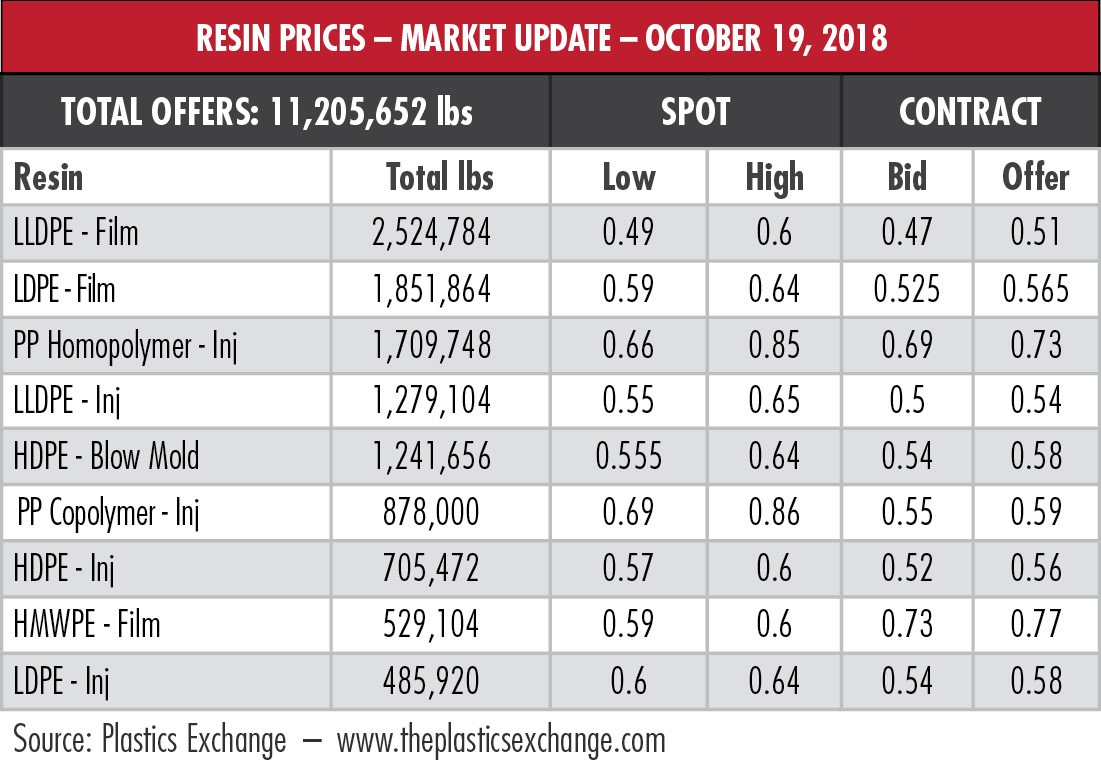
The locomotive that is the U.S.-China trade conflict continues its slow, inexorable journey forward, disturbing no one but those with a clear view of the cliff and the sign that reads: Welcome to 2019.
Recent warnings concern petrochemicals.
 “In September, polyethylene export volumes pulled back for the first time in seven months, but have still been surprisingly resilient in the face of the Chinese tariffs,” said The Plastics Exchange. “Even at September’s lower export tally of 1.15 billion pounds, which was about 130 million pounds below the all-time record just made in August, exports have ratcheted up to a new norm.”
“In September, polyethylene export volumes pulled back for the first time in seven months, but have still been surprisingly resilient in the face of the Chinese tariffs,” said The Plastics Exchange. “Even at September’s lower export tally of 1.15 billion pounds, which was about 130 million pounds below the all-time record just made in August, exports have ratcheted up to a new norm.”
So far, so good. Whether it stays that way is another issue. Many investors and economists have viewed the buildup of tariffs as a temporary annoyance that would dissolve ahead of the U.S. midterm elections in November. Their logic was that the two countries would not risk the economic damage of a prolonged trade war.
However, that is not how it is playing out.
“There is quite a lot of talk now that this is going to be a permanent new situation, that we are heading for a new cold war,” Patrik Schowitz, global strategist at J.P. Morgan Asset Management, told CNBC. “So, I think people are starting to price in the worst possible outcome.”
 J.P. Morgan’s expectation is that the Trump administration will impose tariffs on all Chinese imports, which will precipitate “real painful economic events in 2019,” said Haibin Zhu, the bank’s chief China economist at a recent conference in Hong Kong.
J.P. Morgan’s expectation is that the Trump administration will impose tariffs on all Chinese imports, which will precipitate “real painful economic events in 2019,” said Haibin Zhu, the bank’s chief China economist at a recent conference in Hong Kong.
The slow-motion escalation of tensions began with lists of products to be tariffed totaling about $34 billion that were released by both countries on July 6. No products on the list from China included chemical or plastic products exported by the U.S.
The revised Aug. 8 list included products in the resin category, affecting plastic product exports worth $862 million in 2017. The third list would affect $60 billion worth of U.S. exports, exposing chemicals and plastics exports, valued at $8.8 billion in 2017, to tariffs, according to estimates by the American Chemistry Council.
In a recent assessment, the council argued that “Chinese tariffs on U.S. chemical and plastics exports will lead to a reduction in demand for those exports,” resulting in a loss of as much as $6.1 billion annually.
And it’s not just a short-term loss of jobs and production during the course of a particular trade war. China is in the process of eliminating barriers to supply and customers in other markets, the council said, allowing its economy to grow without relying on imports from the U.S. Once Chinese businesses have found other sources, U.S. exporters will be hard-pressed to regain a foothold in that market.
 The hypothetical NGL barrel at Mont Belvieu, Texas, dropped 8.1% last week to end its four-week run over $40. Ethane fell 14.2% to its lowest point since the first week of September.
The hypothetical NGL barrel at Mont Belvieu, Texas, dropped 8.1% last week to end its four-week run over $40. Ethane fell 14.2% to its lowest point since the first week of September.
Propane sunk below $1 a gallon (gal) for the first time since mid-August. Both butanes suffered 10% weekly drops and C5+ dipped as well.
In the week ended Oct. 12, storage of natural gas in the Lower 48 experienced an increase of 81 billion cubic feet (Bcf), the U.S. Energy Information Administration reported, compared to the Bloomberg survey’s 89 Bcf. The figure resulted in a total of 3.037 trillion cubic feet (Tcf). That is 16.5% below the 3.638 Tcf figure at the same time in 2017 and 16.6% below the five-year average of 3.642 Tcf.
Joseph Markman can be reached at jmarkman@hartenergy.com or @JHMarkman.
Recommended Reading
Texas Gas Vital to Mexico’s Nearshoring Boom
2024-10-25 - Continued U.S. piped-gas exports to Mexico bode well for Eagle Ford and Permian producers.
Commentary: Maximizing the Opportunity for Energy Dominance
2024-12-18 - Energy produced in the U.S. already has a strong grip on global markets. But with the country on the cusp of a new regulatory environment, will the U.S. capitalize on the opportunity to maximize energy dominance?
Analysts: DOE’s LNG Study Will Result in Few Policy Changes
2024-12-18 - However, the Department of Energy’s most recent report will likely be used in lawsuits against ongoing and future LNG export facilities.
Dell: Folly of the Forecast—Why DOE’s LNG Study Will Invariably Be Wrong
2025-01-07 - Kimmeridge’s Ben Dell says the Department of Energy’s premise that increased LNG exports will raise domestic natural gas prices ignores a market full of surprises.
Hirs: Expansive Energy Policies Set to Shape 2025 Markets
2025-01-02 - The incoming administration’s policies on sanctions, tariffs, regulations and deportations will impact the oil and gas industry.
Comments
Add new comment
This conversation is moderated according to Hart Energy community rules. Please read the rules before joining the discussion. If you’re experiencing any technical problems, please contact our customer care team.






